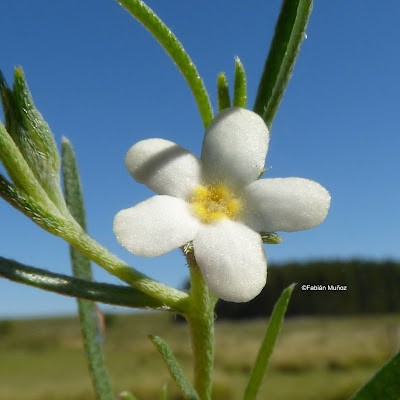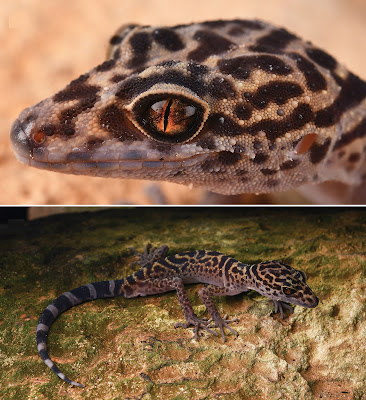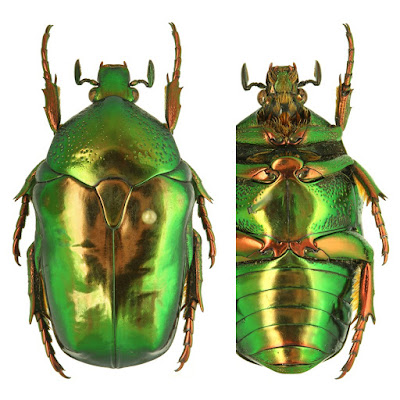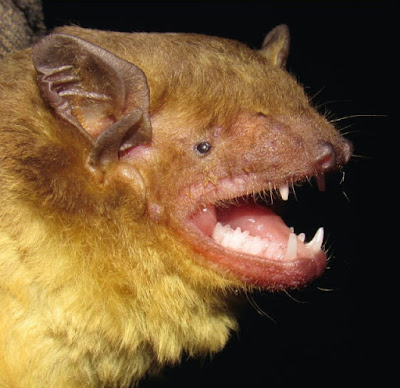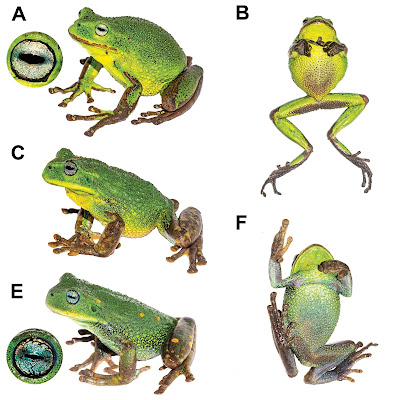[Most Recent Entries] [Calendar View]
Sunday, April 11th, 2021
| Time | Event | ||||||
| 1:11p | [Botany • 2020] Antiphytum charruasorum (Boraginaceae) • White Flowers in South America: A New Species of Antiphytum from western Uruguay
Abstract Antiphytum charruasorum, a new endemic species from western Uruguay, is described. This is the only South American species in the genus with white corolla and an infra-medial cicatrix on the ventral face of the eremocarp, both features shared with the North American species of Antiphytum, in sharp contrast with the blue corolla and the basal cicatrix at the end of a stipe-like prolongation that characterizes all South American species in the genus. Antiphytum charruasorum increases the diversity of the genus in South America, as well as the endemism and distribution range into Uruguay. Moreover, this new species adds novel features in Antiphytum such as the irregularly dichasial inflorescences, the hirsute faucal appendages, the eremocarps with a tissue plug from the gynobase, and the habitat where the species has been reported. Nidia Mendoza-Díaz, Marina Díaz, Patricia Brussa, Fabián Muñoz, José M. Bonifacino and Hilda Flores-Olvera. 2020. White Flowers in South America: A New Species of Antiphytum (Echiochiloideae, Boraginaceae). Systematic Botany. 45(4); 913-920. DOI: 10.1600/036364420X16033963649291 | ||||||
| 1:21p | [Herpetology • 2020] Goniurosaurus gollum • The Stoor Hobbit of Guangdong: A Cave-dwelling Leopard Gecko (Squamata, Eublepharidae) from South China
Abstract A new species of the genus Goniurosaurus is described based on three specimens collected from a limestone cave in Huaiji County, Guangdong Province, China. Based on molecular phylogenetic analyses, the new species is nested within the Goniurosaurus yingdeensis species group. However, morphological analyses cannot ascribe it to any known species of that group. It is distinguished from the other three species in the group by a combination of the following characters: scales around midbody 121–128; dorsal tubercle rows at midbody 16–17; presence of 10–11 precloacal pores in males, and absent in females; nuchal loop and body bands immaculate, without black spots; iris orange, gradually darker on both sides. The discovery of yet another limestone-adapted species of Goniurosaurus in Guangdong Province underscores a growing body of evidence for the high biodiversity of limestone habitats and brings into sharp focus the urgent need for their conservation. Keywords: Goniurosaurus gollum, sp. nov., karst, limestone cave, taxonomy, systematics Goniurosaurus gollum Qi, Wang, Grismer, Lyu & Wang, sp. nov. Diagnosis: Goniurosaurus gollum sp. nov. can be distinguished from all other congeners by the following combination of characters: (1) adult body size moderate, 91.0–93.4 mm SVL; (2) nasal scales surrounding nares seven or eight; (4) internasal single; (5) eyelid fringe scales 59–63; (6) granular scales of upper eyelids similar in size to those on top of head; (7) scales around midbody 121–128; (8) longitudinal dorsal tubercle rows at midbody 16 or 17; (9) paravertebral tubercles between limb insertions 25 or 26; (10) claws sheathed by four scales, dorsal claw scales small, two lateral claw scales short and shell-shaped; (11) axillary pockets deep; (12) presence of 10 or 11 precloacal pores in males and absent in females; (13) dorsal ground color of head, body, and limbs in adults yellowish brown and mottled with irregularly shaped dark-brown blotches; (14) nuchal loop complete, rounded posteriorly; (15) presence of three or four thin dorsal body bands between nuchal loop and caudal constriction, with black anterior and posterior borders, bands usually irregularly shaped; (16) iris orange, gradually darker on both sides.
Etymology The specific epithet “gollum” is named after the fictional character, Gollum, from J.R.R. Tolkien’s The Lord of the Rings book series. This new species and Gollum have similar cave-dwelling habit and emaciated body. We suggest the common name as “Gollum Leopard Gecko”, and according to the type locality, we suggest the Chinese formal name as “guǎng dōng jiǎn hǔ” (广东睑虎). Distribution and ecology: Currently, Goniurosaurus gollum sp. nov. is known only from Huaiji County, Guangdong Province, China. All individuals were found within a barren limestone cave approximately 50 m from the cave entrance at night after 2130 hrs (Fig. 5). The surface of the cave is covered with bat (unidentified) and bird (Apus pacificus) droppings. Stalactites are suspended from the roof and there is no vegetation. Duttaphrynus melanostictus was observed in the same area. Shuo Qi, Jian Wang, L. Lee Grismer, Hong-Hui Chen, Zhi-Tong Lyu and Ying-Yong Wang. 2020. The Stoor Hobbit of Guangdong: Goniurosaurus gollum sp. nov., A Cave-dwelling Leopard Gecko (Squamata, Eublepharidae) from South China. ZooKeys. 991: 137-153. DOI: 10.3897/zookeys.991.54935 | ||||||
| 1:30p | [Entomology • 2021] Protaetia (Macroliocola) dianae • A New Species and A New Country Record in the Genus Protaetia Burmeister, 1842 (Coleoptera: Scarabaeidae: Cetoniinae) from Vietnam
Abstract Protaetia (Macroliocola) dianae Mückstein, a new species of fruit chafer (Coleoptera: Scarabaeidae: Cetoniinae) from northern Vietnam is described. Habitus and diagnostic features of the new species are illustrated. A new country record of Protaetia (Liocola) miharai (Alexis & Delpont, 1998) for Vietnam is presented. Keywords: Coleoptera, Scarabaeoidea, Lamellicornia, Macroliocola, Liocola, taxonomy, new species, faunistic, Vietnam, Oriental Region Petr Mückstein. 2021. A New Species and A New Country Record in the Genus Protaetia Burmeister, 1842 (Coleoptera: Scarabaeidae: Cetoniinae) from Vietnam. Zootaxa. 4952(1); 192-200. DOI: 10.11646/zootaxa.4952.1.12 | ||||||
| 1:31p | [Mammalogy • 2020] Integrative Taxonomy and Biogeography of Asian Yellow House Bats (Vespertilionidae: Scotophilus) in the Indomalayan Region
Abstract Yellow house bats (Scotophilus) have been known for centuries as a widespread genus of vesper bats in the Indomalayan Region. Despite this, their taxonomic status and phylogeographical patterns remain unclear due to differing criteria employed by early taxonomists and inconsistencies between morphological and molecular assessments. To address these issues, we undertook a comparative phylogeographic analysis of Asian Scotophilus spp. using integrated genetic and morphological analyses of samples collected across the region. These demonstrate that yellow house bats in Asia can be classified into just two widespread species, namely the smaller S. kuhlii (e.g., FA ≤ 53.1 mm, GLS ≤ 20.18 mm) and the larger S. heathii (e.g., FA ≥ 53.4 mm, GLS ≥ 20.85 mm), which occur in sympatry in different parts of the Indomalayan Region. Although these two sympatric species share similar eco‐ethological preferences, they differ considerably in their geographic distributions and intraspecific variation in mtDNA sequences and morphological traits. These disparities were likely misinterpreted as indicating potential cryptic diversity in previous studies, whereas we suggest they are related to interspecific differences in sex‐biased gene flow and phenotypic plasticity to adapt to varying environments. Our study highlights the importance of using multiple datasets to resolve taxonomic uncertainties and reconstruct demographic and phylogeographic histories of sympatric species. Keywords: comparative phylogeography, integrative taxonomy, multiple datasets, Scotophilus, sympatric species Vuong Tan Tu, Tamás Görföl, Gábor Csorba, Satoru Arai, Fuka Kikuchi, Dai Fukui, Daisuke Koyabu, Neil M. Furey, Saw Bawm, Kyaw San Lin, Phillip Alviola, Chu Thi Hang, Nguyen Truong Son, Tran Anh Tuan and Alexandre Hassanin. 2021. Integrative Taxonomy and Biogeography of Asian Yellow House Bats (Vespertilionidae: Scotophilus) in the Indomalayan Region. Journal of Zoological Systematics and Evolutionary Research. 59(3); 772-795. DOI: 10.1111/jzs.12448 Cover: Yellow house bats (Scotphilus) have been known for centuries as a widespread genus of vesper bats in the Indomalayan Region, yet their taxonomy, phylogeny, and phylogeography remain unclear. In a comparative phylogeographical study, Tu et al show that Asiatic Scotophilus comprise just two morphologically distinct species that co‐occur in many parts of the region, namely the smaller S. kuhlii and the larger S. heathii. Although these two species have similar eco‐ethological preferences, they differ considerably in their demographic and phylogeographic patterns, and vary geographically in their morphological traits. These divergences may reflect adaption to differing environments and interspecific competition in areas of sympatry during their evolutionary history. The cover image features a male of the Greater Asiatic yellow house bat, S. heathii, from Kampong Speu province, Cambodia. Tu et al. 2021. Journal of Zoological Systematics and Evolutionary Research. Volume 59, Issue 3, Pages 772–795, DOI: 10.1111/jzs.12448. photo by Neil M. Furey. | ||||||
| 2:01p | [Herpetology • 2021] Gastrotheca gemma • A New Species of Marsupial Frog (Anura: Hemiphractidae: Gastrotheca) from the Cordillera de Colán in northeastern Peru
Abstract We describe a new species of marsupial frog, genus Gastrotheca, using morphological characters and molecular data as lines of evidence. The new species was discovered in the páramo and the ecotone between páramo and humid montane forest of Cordillera de Colán, at elevations between 3136 and 3179 m a.s.l., in northeastern Peru. The new species is distinguished from all its congeners by the combination of the following characters: coarsely granular skin on dorsum, a green dorsal coloration without pattern, finger I shorter than finger II, turquoise iris, and a venter without blotches, flecks or dots. Furthermore, we include a detailed osteological description of the new Gastrotheca species based on Micro-CT scanning. Based on our phylogenetic analyses, the new species belongs to the Gastrotheca marsupiata species group, is sister to G. oresbios and closely related to G. psychrophila, G. spectabilis, G. stictopleura and one undescribed species. Additionally, we test for the presence of the fungal pathogen Batrachochytrium dendrobatidis (Bd). No Bd infection was detected for Gastrotheca gemma sp. nov. specimens but Bd prevalence was detected among syntopic frogs. Keywords: Amphibians, Andes, Batrachochytrium dendrobatidis, Gastrotheca abdita, Hemiphractidae, osteology, phylogeny
Gastrotheca gemma sp. nov. Diagnosis: Assigned to the genus Gastrotheca by females possessing a closed brood pouch on the dorsum. A moderately large species (69.7 and 71.8 mm SVL in two females, 56.9 and 59.5 mm SVL in two males), with: (1) tibia length 57–59% SVL, longer than foot; (2) interorbital distance greater than width of upper eyelid (161–169%); (3) skin on dorsum coarsely granular in females and granular in males, not co-ossified with skull, lacking transverse ridges; (4) supraciliary processes absent; (5) heel lacking calcar or tubercle; (6) tympanic annulus wrinkled or tuberculate; (7) Finger I slightly shorter than Finger II, width of discs wider than digits; (8) finger webbing present basally, only between III and IV; (9) foot webbing between external toes extending to nearly antepenultimate subarticular tubercle on Toe IV, to penultimate subarticular tubercle on Toe V; (10) in life, dorsum green with numerous minute black flecks in females and green with scattered yellow dots in males, paravertebral marks absent; (11) head markings consisting of a chocolate or pale green labial stripe in females and males, respectively; (12) dorsolateral stripe absent; (13) flanks uniformly green in females and green with numerous dark green irregular flecks in males; groin yellowish green in both sexes; anterior surfaces of thighs green, posterior surfaces of thighs yellowish green with scattered irregular black flecks in females and dense black reticulations in males; ventrolateral region yellowish green; irises silvery with a light blue hue or turquoise with thin black reticulations with or without an orange ring; (14) gular region and chest green in females and yellowish green in males; venter yellowish green with or without a big dark grey patch in the middle in females and venter greenish cream in males; ventral surface of thighs yellowish green with a dark greyish brown patch on the centre in females and thighs pale brownish cream in males; palms, soles and ventral surface of tarsus dark grey or dark greyish brown; (15) brood pouch single, dorsal; (16) reproduction mode direct development. ... Etymology: The specific epithet comes from the Latin word “gemma”, a substantive meaning precious stone or gem. This specific name is used in apposition and refers to the turquoise coloration, in life, of the eyes of the new species of marsupial frog, which resembles the coloration of a turquoise stone.
Pablo J. Venegas, Luis A. García-Ayachi, Lourdes Y. Echevarría, Daniel J. Paluh, Juan C. Chávez–Arribasplata, Axel Marchelie and Alessandro Catenazzi. 2021. A New Species of Marsupial Frog (Anura; Gastrotheca) from the Cordillera de Colán in northeastern Peru. Vertebrate Zoology. 71: 201-218. DOI: 10.3897/vz.71.e60097 |
| << Previous Day |
2021/04/11 [Calendar] |
Next Day >> |
